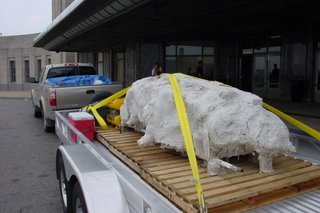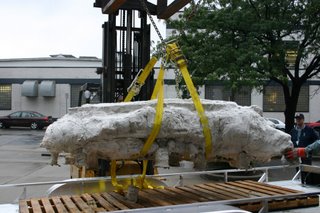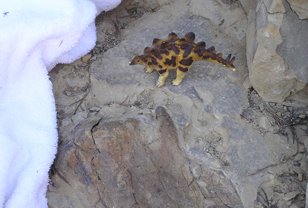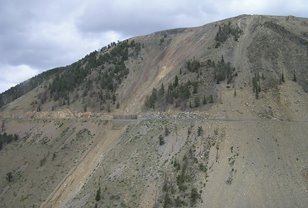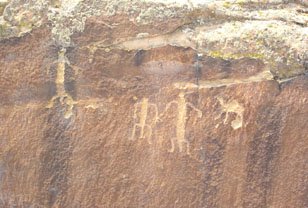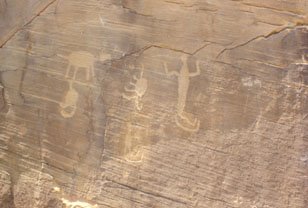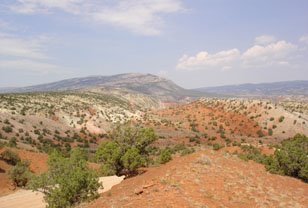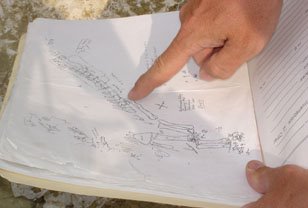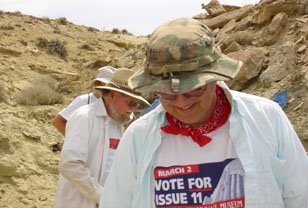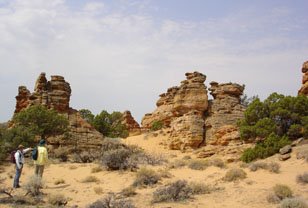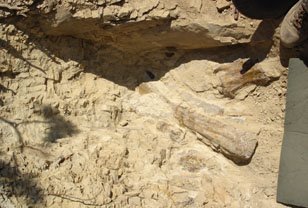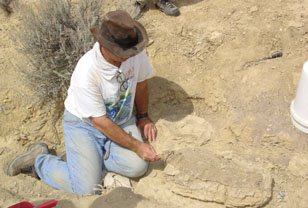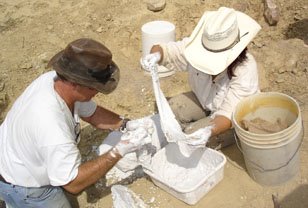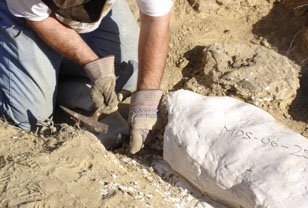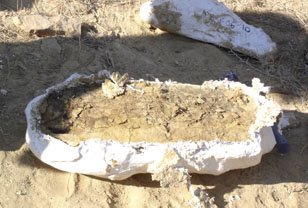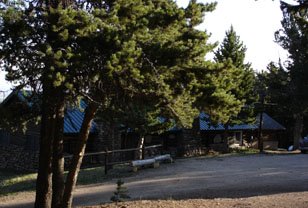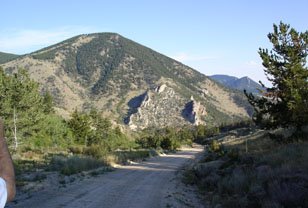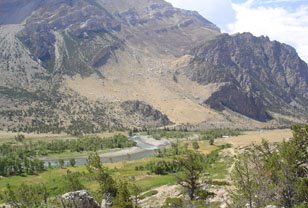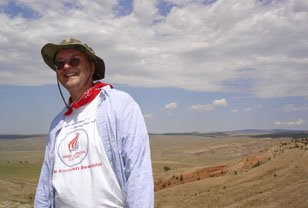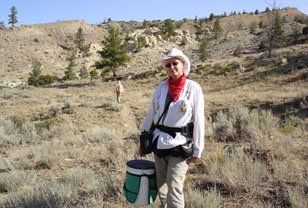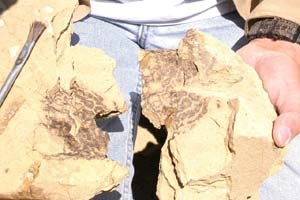I'm the field supervisor, which means that I spend pretty much all my time in the field -- hence this being my first entry, accomplished from an internet cafe in Red Lodge on a mission to procure more burlap. Meet our happy band!
We've been here almost three weeks now and it feels much longer. That isn't to say we aren't loving it; it means that the place hasn't changed a bit, and it feels like we never left. We are the core team of this expedition, the here-for-the-duration people who camp at the digsite and live, eat, and breathe fossils every summer. We look forward to this all year. Within hours of arriving we have fallen back into the good old patterns that sustain us in this place.
Our patterns begin with tent placement. Once we have established that the dirt road up to our campsite has sufficiently weathered the winter to allow us access, we gingerly bump the vans over the ruts and around the ditches to the narrow valley where we make camp every year. We set up personal tents first. I favor a particular low ditchy area despite its proximity to a fire ant nest because I'm avoiding wind; I have a stupidly tall tent (but it was on sale!). Sara knows better, the hard way: HER tall tent was destroyed in our Great Hail Storm of 2004. Sara confidently assembles her low, wide alpine tent right out in the open; she says it doesn't even rustle in the breeze. Mac sets up right at the common area -- he likes to be in the middle of things. Don, who endured the Great Hail Storm from underneath a van, has decided to live IN a van this year -- no tent for him. But true to his nature, Don is going the extra mile to bring civilization to our midst. He's brought a portable gazebo, "suitable for weddings and family reunions," and he intends to fill it with comfortable seating and music and DVDs run off a small generator. The wind takes takes the whole thing down in about five minutes. Eventually we get it standing but only without its legs, so it's about three feet off the ground. We call it the media yurt and crawl in to play board games sometimes.
We arrange crates of gear in a rough square and call it the living room; we put the propane stove and sink at one end and call it the kitchen. Then we grab shovels and pickaxes and trek over the rise to the digsite. It's a short walk but it's steep and we've gained about 4000 feet in elevation since Cincinnati three days earlier. Our goal now is to uncover the digsite, but we're already worn out and not much gets done that first day.
It's 15 miles to the tiny town of Bridger. We stock up on food (Tuna Helper, Chicken Helper, all the Helpers -- it's mainly mush-meals-in-a-skillet from here on). The Maverik gas station graciously allows us to fill our water jugs from their hose. And the Bridger Cafe makes the world's best milkshakes.
Back at the digsite, we are moving a lot of earth. We bury the site at the end of every season, to hide and sort-of protect it, but there's still a lot of bone washing out. We have our work cut out for us. Fossil bone is crumbling from every slope, turning blue in the sun and wind. We collect the stray chunks, called "float," and dig on the spot and there they are: ribs galore, two scapulae, maddeningly complex cervical vertebrae, a perfect and robust tibia, a radius and ulna neatly side-by-side. A whole herd of young sauropods jumbled like pick-up sticks -- an apt comparison, because removing them is LIKE playing pick-up sticks; your'e working away on one bone and whoops, there's another right on top of it. The happy cries of discovery turn to cries of dismay -- "Oh no! More bone!" -- as your initial, say, cervical is found to be blocked in by, say, a rib, and then another, and another. Patience, patience.
Sara is only 18 but she's been working with fossils for years now and she's very good at it. Furthermore, she possesses that knack for knowing where to dig that is beyond skill -- you either have it or you don't. She's found skin impressions here before (very cool) and now it looks like she's got skull. Everyone's jealous.
The cervicals that Don was removing have proven to be heavily blocked in by other elements, ribs and caudels, and yike, yet more cervicals. They will all have to come out together, in one enormous block. How will we ever move it? It keeps getting bigger. Don isn't having fun; the rock is very hard in that spot. His hammer blows are regular and constant but he knows what has to be done; some people would lose their temper and chop the block apart anyway and lose half of it, but not Don. Still, he keeps volunteering for lousy but needful tasks, like digging latrine trenches, just for a break from that awful block. Everything he does is so silent and steady -- so unspectacular are his methods -- that his spectacular results catch one off guard, as does his dark and pointy-sharp wit. I've done field work with Don for three seasons now, and he is always a surpise.
Mac has found a lovely string of tailbones. He is, like Sara, 18, and also a freshman at UC. Also, like Sara, Mac started young -- he first wrote Glenn, my boss, an email declaring his paleontological aspirations when he (Mac) was in the eighth grade. Mac's family breeds Clydesdales. The best qualities for excavating fossils -- patience, care, a steady, smooth hand, the right balance of physical strength and delicacy, intuition -- are perhaps not coincidentally the best qualities in horsework. Mac will do fine.
Dale's little red car came creeping up the path a few days later, diven, as usual, by Sam. Dale curates the Orton Geological Museum in Columbus and digs up fossils at every opportunity; one's first impression of Dale is of a happy man who loves his work. He fairly bubbles with enthusiasm, he bounces on the balls of his feet when he talks, and even his hair has a springy, fresh-popped popcorn look to it. Sam, by contrast, is tall, lean, and rangy and cultivates a Toshiro Mifune scowl, which belies his good nature, most evident when he's trading cheerful barbs with Dale. He calls Dale "Boss," which he hasn't literally been for some time -- they are actually an excellent father-son team, and it doesn't matter that they aren't related by blood. They have been working here every summer for seven years now, and they are essential to the mix.
And then came Glenn, the big boss, my boss. Why does the boss always arrive just when one is taking a much-needed heat-of-the-day siesta? But Glenn was in high spirits. For starters, he had driven out from Cincinnati in our departments' brand-spanking-new Tundra pickup, and the thing rides like a dream. Secondly, he was here, and here is wonderful, even if the temperatures are topping a hundred and the land is not only dry, it's CRISP. We wake up with dust in our throats and cracked nostrils, and everyone's hair looks like something you vacuum up from under the bed. "Good thing it's a dry heat, though," we say to each other about ten times a day -- our brains are too fried to be more creative.
Evenings are different. It cools off fast in the desert; rocks and scrub don't hold much heat. We haul ourselves back to camp around fiveish and slump dull-eyed in our lawn chairs with our backs to the blazing horizon. We slowly recover our senses and fluid levels. Whoever cooks dinner doesn't have to clean up -- that's the rule. It doesn't get dark until 10-10:30, so post-mealtime falls at just about the golden hour, a term that applies here like no where else. I have photos taken in these excellent early-evening hours from previous years, and anyone who sees them thinks I had a colored filter on my lens. But this is what it looks like: us, relaxed, fed, happy, cooling off (even in light jackets by now), bathed in a deep orange glow. We've assembled our chairs in a semicircle by now and we're sufficiently energized for the evening's shenanigans, which could be and have been:
-- board games. Dinosaur Monopoly, Cranium, poker, and weiqi, everybody in the media yurt, hunched like trolls.
-- target practice. Air rifles, bows and arrows, 22 calibers, and a slingshot, all trained on poor Mrs. Butterworth (now emptied of syrup), a half a rancid watermelon, a rubber glove full of plaster.
-- juvenile practical jokes. What if you woke up to find Mrs. Butterworth full of buckshot and a green glowstick in your tent vestibule? What if Sam did?
-- scorpion racing. They flouresce. Once you've walked around at night with a portable blacklight, you find out they are everywhere, and you'll never wear those Tevas out here again -- you're lucky if you can sleep. Or, if you're Sara, you build a racetrack from cardboard tubing and duct tape. Race 'em, trade 'em, keep them in a coffee can and feed 'em yellowjackets!
-- killing yellowjackets. They are everywhere this year, like never before. But, hard up for entertainment, anything can be a sport. Keep score! The battery-powered electric tennis racket provides, no kidding, hours of bug-zappin' fun.
-- stargazing. We all agree that it's impossible to describe this night sky to anyone back home. The Milky Way is a big white SMEAR, if that gives you any idea. We identify constellations, invent new ones. The Perseid meteor shower is in town for its annual run; we are struck dumb with awe.
-- search for topographical features, against all common sense. Don insists that "Depression Reservior" is on the map and within a two-mile radius. We pile in the back of the pickup and head out across the bone-dry, featureless plain. It turns out to be a cow wallow in a ditch about the size of someone's above-ground swimming pool. Don is disappointed -- he actually brought a fishing pole.
-- go swimming, get cleanish! Not in Depression Reservior, but in Cooney Reservior about 50 miles away. Yes it's muddy, but what a treat, not to mention the first opportunity to bathe in a week. Dr Bronner's soap is biodegradable and also has very entertaining label copy. What's a little mud? This is the desert, people, you think water grows on trees?
-- s'mores. Why not?
-- call home. It can now be done. Take a short walk to high ground and talk as long as your overheated cell phone battery will allow.
-- pointless bickering. There are, apparently, only three REAL Star Wars movies, and some people feel strongly about this.
-- the art of conversation. It's not all dinosaurs and Stargate.
-- actual work. Not much. That's one of the great beauties of being out here. No email, nothing you've been procrastinating on at the back of your mind -- the tasks at hand are what we got.
Every now and then someone (usually someone very YOUNG) tries to explain to me how we could get a satellite hookup out here, get online, get back in the real world. Ha. Ha. Ha.
More to come!
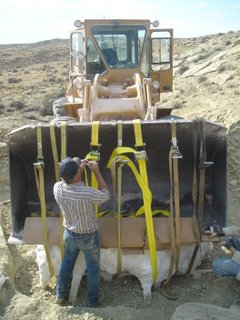 3,500-lb Dodson block is attached to the front-end loader.
3,500-lb Dodson block is attached to the front-end loader.

